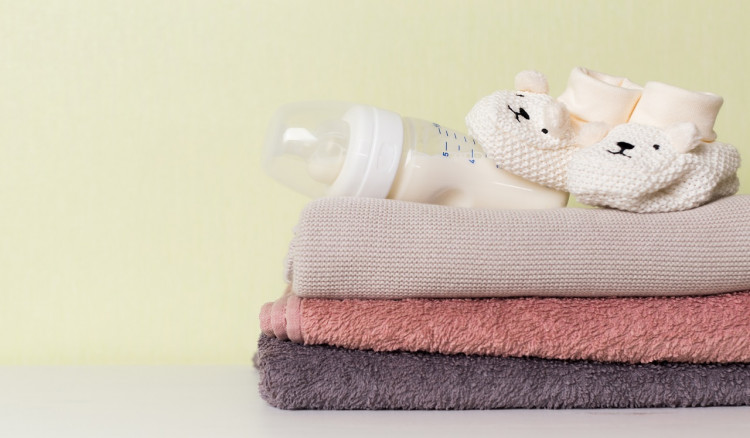
Essential Baby Items You Need
You should have the following items ready when you come home with the baby. Not everything need be new. Ask friends or relatives with small children for good equipment and clothes they are no longer using; the baby doesn’t care about fancy cribs or nightgowns—just comfort. Buy clothes in the six-month or one-year size; the three-month size is outgrown too quickly.
Essential Baby Items List
Baby Clothing
- Four to six dozen cloth diapers, or a two-week supply of infant-size disposables (you will use about 10 a day), or one or two dozen diapers to supplement diaper service. Pre-folded diapers save time, and you can get extra-small ones for newborns
- A half-dozen diaper pins with safety guards
- Two or three pairs waterproof pants, preferably silk or nylon. Rubber pants cause sweating
- Four to six shirts, long- or short-sleeved according to weather and house temperature (snap-closed shirts are easier to put on the baby than pullovers)
- Four to six cotton knit nightgowns or kimonos
- Four to six terry stretch suits that snap down the front. These can be used instead of nightgowns if you prefer, but it is handy to have both
- Two sweaters
- A hooded wrap, bunting, or outdoor pram suit—how warm depends on the weather.
- A heavyweight blanket sleeper—for a cold bedroom or for an active baby who wiggles out of blankets
- Bootees or socks (optional)
- Three or four bibs
Baby Bedding
- A crib with a firm, waterproof mattress. Be certain that only unleaded paint has been used on the crib’s sides. You can also improvise a bed from a sturdy box, basket, or bureau drawer, using a foam pad or smoothly folded blanket for a mattress. Carefully cover any sharp or rough edges on the sides of the bed, and make sure sides are secure and spaces between crib rails are narrow enough so the baby’s head cannot get wedged. Do not use a pillow
- A waterproof case for the mattress or pad, and two or three pieces of waterproof flannelette sheeting large enough to cover it (smaller waterproof pads to place directly under the baby’s body in the crib, or to use as lap pads, are also handy)
- Three or four fitted crib sheets
- Three or four quilted pads (optional), to place between sheet and waterproof pad if weather is hot or the baby’s skin is especially sensitive.
- Three or more cotton flannel ‘receiving’ blankets to use as towels, as summer blankets, and as bundling for the baby
- One or two warm blankets of wool or acrylic
- Crib bumpers, to keep the baby’s head from pressing against the crib rails
Baby Furniture
- A table or wide-topped bureau on which to dress and change the baby. Make sure the height is convenient for you—about hip-level is usually best. You can secure a pad on top of it for the baby to lie on and hang a sturdy shelf above it, out of his reach, for diaper pins, lotion, cotton balls etc.
- A comfortable rocker or armchair for the parent to sit in during feedings
- A playpen (preferably with mesh sides) and pad. Used judiciously, a playpen will not thwart your baby’s need to explore but will provide a safe place for him to play while you work or relax for a while
Baby Feeding Equipment
If you nurse your baby, you will need only a few bottles, for the ‘relief’ bottle and for water or juice
- Eight to ten 0.2kg bottles and three or four 0.1kg bottles (for water or juice); or a disposable nurser kit and refills. Get plastic or Pyrex bottles. They should come with nipples, caps, and bottle covers or disks
- Extra nipples
- Bottle and nipple brush
- Feeding dish and spoons for solid foods
- Long-handed stirring spoon (for mixing powdered formulas)
- Formula: you can buy prepared infant formulas in powdered concentrate liquid or ready-mixed form
- If you prepare your own formula at home, you may want a sterilizer kit, glass measuring cups in 0.2kg and 0.9kg sizes, measuring spoons, a funnel, and stirring spoons. Ask your doctor to give you a suitable formula. Buy the necessary ingredients ahead of time
Baby Bathing Equipment and Toilet Articles
- Three to four soft towels and washcloths
- A plastic baby tub with a wide rim on which you can rest your arm
- A tray to hold bath supplies (optional)
- Pure, unmedicated soap and a soap dish
- Baby shampoo (optional)
- Cotton balls (not cotton-tipped sticks)
- Baby brush and comb
- Baby nail scissors with safety points
- Diaper-rash ointment
- Baby lotion or premoistened baby wipes for cleaning diaper area after changes
- Bath apron to protect parent’s clothes
Other Baby Supplies and Equipment
- Mild laundry soap for soaking and washing diapers and baby clothes
- A rectal thermometer
- Petroleum jelly for use in thermometer
- A one- or two-gallon, rustproof diaper pail
- Mosquito netting to place over the crib if there are insects in the baby’s room
- A room thermometer
- For outings: a baby carriage, a sling carrier, or a reclining infant seat-carrier (also useful as a baby’s feeding chair) in which the child can be securely strapped
- A car bed, if you take a lot of automobile trips. Get one that anchors securely to the car’s back seat
- A diaper bag to hold diapers, bottles, lotions etc. during trips
- Night-lights for hallways and baby’s room
- Baby record book, for keeping records of weight, immunizations, new teeth, etc.
- Cold-water vaporizer to keep air from getting too dry in the baby’s room, especially when she has a cold
Sources and References
Reader’s Digestive Family Health Guide and Medical Encyclopedia






Share This Article: